Regorafenib monohydrate
Synonym(s):4-[4-[[[[4-Chloro-3-(trifluoromethyl)phenyl]amino]carbonyl]amino]-3-fluorophenoxy]-N-methyl-2-pyridinecarboxamide monohydrate
- CAS NO.:1019206-88-2
- Empirical Formula: C21H17ClF4N4O4
- Molecular Weight: 500.83
- EINECS: 1308068-626-2
- SAFETY DATA SHEET (SDS)
- Update Date: 2024-11-19 23:02:33
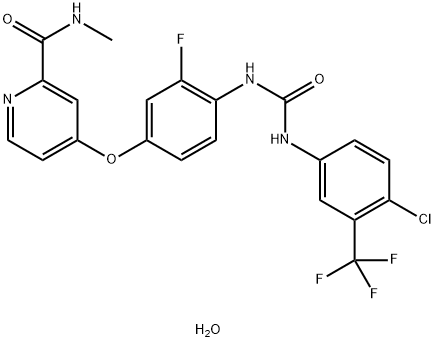
What is Regorafenib monohydrate?
Description
Regorafenib monohydrate (BAY 73-4506) is an orally active and potent multi-targeted receptor tyrosine kinase inhibitor with potent anti-tumour and anti-angiogenic activity. It is approved for the treatment of metastatic colorectal cancer, advanced gastrointestinal mesenchymal stromal tumours and hepatocellular carcinoma.
The Uses of Regorafenib monohydrate
4-[4-[[4-Chloro-3-(trifluoromethyl)phenyl]carbamoylamino]-3-fluorophenoxy]-N-methylpyridine-2-carboxamide Hydrate can be used as an anti-tumor drug.
Definition
ChEBI: Regorafenib hydrate is a hydrate that is the monohydrate form of anhydrous regorafenib. Used for for the treatment of metastatic colorectal cancer in patients who have previously received chemotherapy, anti-EGFR or anti-VEGF therapy. It has a role as an antineoplastic agent, a tyrosine kinase inhibitor and a hepatotoxic agent. It contains a regorafenib.
Biological Activity
regorafenib monohydrate is a multitargetedinhibitor of tyrosine kinase with ic50 values of 13nm, 4.2nm, 46nm, 2.5nm, 28nm, 19nm, 202nm, 22nm, 7nm, 1.5nm and 311nm, respectively for vegfr-1, mvegfr-2, mvegfr-3, raf-1, braf wt, brafv600e, fgfr-1, pdgfr-β, c-kit, retand tie2 [1].regorafenib is a multikinase inhibitor of both intracellular and membrane-bound rtks. it shows potent inhibition of angiogenic and stromal rtks like vegf receptors-1-3, pdgfr-β and fgf receptor-1 with ic50 values ranging from4.2 to 311nm in biochemical assays. it also inhibits oncogenic rtks, such as ret and c-kit, with ic50 values ranging from 1.5 to 28nm in cellular assays [1].regorafenib is reported to have anti-tumor efficacy to various tumors including breast, pancreas, thyroid, melanoma, gist, and crc with a mean ic50 value less than 1μm. these inhibition effects of tumor growth are also found in mouse xenograft models after the treatment of regorafenib at dose ranging from 10 to 100 mg/kg [1].
Mechanism of action
The mechanism of anticancer action of Regorafenib monohydrate is similar to that of Regorafenib, an oral multikinase inhibitor that blocks tyrosine kinases that are active in angiogenesis, cancer development and growth, and maintenance of the tumour microenvironment. It is superior to sorafenib in blocking both vascular endothelial growth factor receptor and TIE2, a molecule with an important role in angiogenesis.
Clinical Use
Regorafenib was approved by the U.S. Food and Drug Administration (FDA) in September 2012 for the treatment of metastatic colorectal cancer in patients who have previously undergone fluoropyrimidine-, oxaliplatin-, and irinotecan-based therapies. The FDA expanded the approved use of the drug to include patients with advanced gastrointestinal stromal tumors (GIST) that cannot be surgically removed and no longer respond to imatinib and sunitinib, two other drugs approved for treatment of GIST. Regorafenib, marketed under the trade name Stivarga®, was discovered and developed by Bayer Pharmaceuticals and marketed jointly with Onyx Pharmaceuticals. The active metabolites of the drug inhibit multiple targets within a variety of kinase families including those in the RET, VEGF, FGFR, PTK, and Abl pathways.
Synthesis
Among several published synthesis, the most likely process scale synthesis will be highlighted from the two published syntheses, and this is described in the scheme. Commercially available picolinic acid (148) was heated with thionyl chloride to provide the crude intermediate 4-chloro-2- pyridyl acid chloride which was subsequently reacted with aqueous methyl amine in toluene to give 4- chloro-2-methylcarboxamide as its hydrochloride salt 149 in quantitative yield after treatment with acetyl chloride in toluene and ethanol. The hydrochloride salt was free based with sodium hydroxide and then immediately reacted with imine 150 (formed upon exposure to 4-amino-3-fluorophenol (153) in refluxing 3-methyl 2-butanone) in base to provide diaryl ether 151 in 84% yield. Reaction of amine 151 with the commercially available isocyanate 152 ultimately delivered regorafenib hydrate (XXIII) in 83% yield.
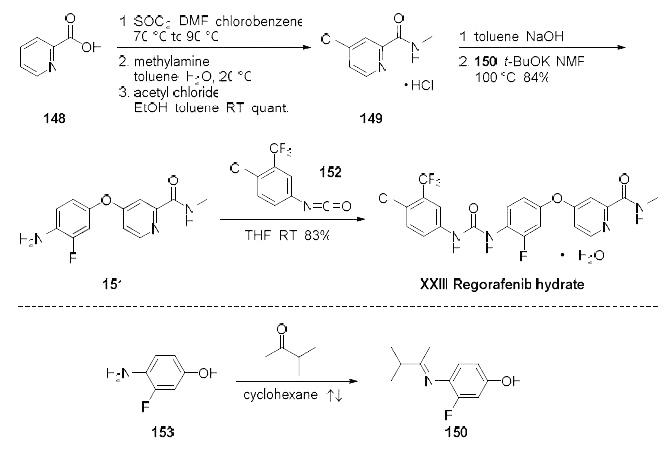
References
[1] crona dj, keisler md, walko cm.regorafenib: a novel multitargeted tyrosine kinase inhibitor for colorectal cancer and gastrointestinal stromal tumors.ann pharmacother. 2013 dec;47(12):1685-96.
Properties of Regorafenib monohydrate
| storage temp. | 2-8°C |
| solubility | ≥25.05 mg/mL in DMSO; insoluble in H2O |
| form | solid |
| color | Light yellow to orange |
Safety information for Regorafenib monohydrate
| Signal word | Warning |
| Pictogram(s) |
 Health Hazard GHS08  Environment GHS09 |
| GHS Hazard Statements |
H373:Specific target organ toxicity, repeated exposure H410:Hazardous to the aquatic environment, long-term hazard |
| Precautionary Statement Codes |
P201:Obtain special instructions before use. P273:Avoid release to the environment. P308+P313:IF exposed or concerned: Get medical advice/attention. |
Computed Descriptors for Regorafenib monohydrate
New Products
Tert-butyl bis(2-chloroethyl)carbamate (S)-3-Aminobutanenitrile hydrochloride N-Boc-D-alaninol N-BOC-D/L-ALANINOL N-octanoyl benzotriazole 4-Hydrazinobenzoic acid 3,4-Dibenzyloxybenzaldehyde 1,1’-CARBONYLDIIMIDAZOLE R-2-BENZYLOXY PROPIONIC ACID 1,1’-CARBONYLDI (1,2-4 TRIAZOLE) 4-HYDROXY BENZYL ALCOHOL 3-NITRO-2-METHYL ANILINE (2-Hydroxyphenyl)acetonitrile 4-Bromopyrazole 5-BROMO-2CYANO PYRIDINE 5,6-Dimethoxyindanone 5-broMo-2-chloro-N-cyclopentylpyriMidin-4-aMine 4-methoxy-3,5-dinitropyridine 2-(Cyanocyclohexyl)acetic acid 2-aminopropyl benzoate hydrochloride 1-(4-(aminomethyl)benzyl)urea hydrochloride tert-butyl 4- (ureidomethyl)benzylcarbamate diethyl 2-(2-((tertbutoxycarbonyl)amino) ethyl)malonate Ethyl-2-chloro((4-methoxyphenyl)hydrazono)acetateRelated products of tetrahydrofuran

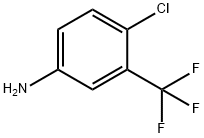
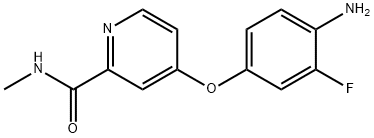

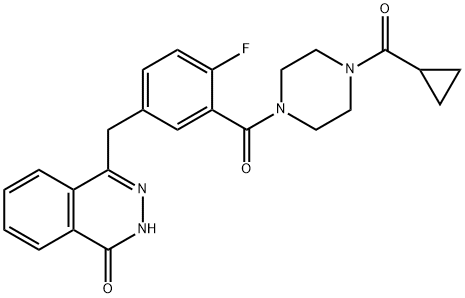
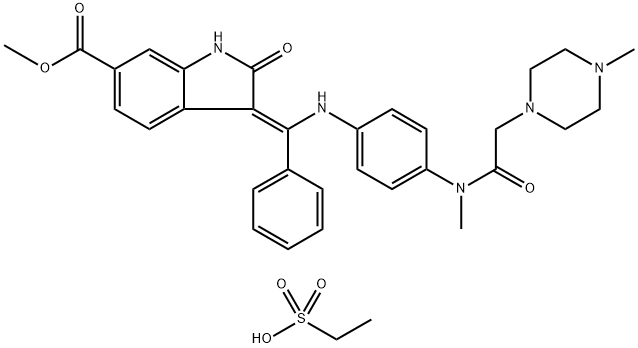

![9-ethyl-6,6-diMethyl-8-(4-Morpholinopiperidin-1-yl)-11-oxo-5a,6,11,11a-tetrahydro-5H-benzo[b]carbazole-3-carbonitrile hydrochloride](https://img.chemicalbook.in/CAS/GIF/1256589-74-8.gif)
You may like
-
 Regorafenib monohydrate 95% CAS 1019206-88-2View Details
Regorafenib monohydrate 95% CAS 1019206-88-2View Details
1019206-88-2 -
 Regorafenib for FP system suitability CAS 1019206-88-2View Details
Regorafenib for FP system suitability CAS 1019206-88-2View Details
1019206-88-2 -
 55441-95-7 99%View Details
55441-95-7 99%View Details
55441-95-7 -
 N-Vinylformamide 99%View Details
N-Vinylformamide 99%View Details
13162-05-5 -
 Chloro Uracil 1820-81-1 99%View Details
Chloro Uracil 1820-81-1 99%View Details
1820-81-1 -
 2-ethyl-6-methyl-3-hydroxypyridine succinate 99%View Details
2-ethyl-6-methyl-3-hydroxypyridine succinate 99%View Details
127464-43-1 -
 2-ETHYLPYRIDINE 100-71-0 99%View Details
2-ETHYLPYRIDINE 100-71-0 99%View Details
100-71-0 -
 181228-33-1 (S)-Methyl 3-amino-2-((tert-butoxycarbonyl)amino)propanote Hydrochloride (DAP-OMe. HCl) 99%View Details
181228-33-1 (S)-Methyl 3-amino-2-((tert-butoxycarbonyl)amino)propanote Hydrochloride (DAP-OMe. HCl) 99%View Details
181228-33-1